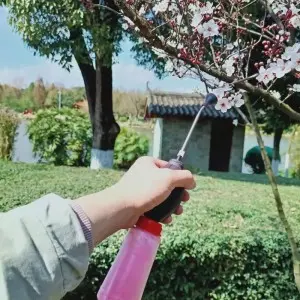Oct . 08, 2025 22:40 Back to list
Artificial Pollination: Faster Fruit Set, Higher Yields—Why?
Lithium Electric Pollinator for Orchard: a field-tested take
If you’ve been watching the quiet revolution in artificial pollination, this one will feel familiar and still a bit exciting. The LITHIUM ELECTRIC POLLINATOR FOR ORCHARD from Hebei’s Zhao county (Caozhuang Development Zone, for the map lovers) has been five years in the making, and—yes—there’s a utility-model international patent behind it. Medium-sized orchards (about 10–20 mu, or roughly 1.6–3.3 acres) are its sweet spot, but I’ve seen folks push the edges.

Industry trend check (short version)
Labor is tight, bloom windows are shorter, and weather’s… let’s say unpredictable. Growers are turning to powered applicators to stabilize fruit set. The shift isn’t hype: consistent dosing and better timing often beat “hope the bees show up.” To be honest, it’s not magic. It’s just control. And artificial pollination gives you a dial to turn when nature won’t.
What’s inside (materials and build)
The unit combines a lithium battery pack, a compact electric motor, a powder storage tank, and an extension rod. Housing: impact-resistant ABS with aluminum alloy frame supports; seals: PTFE to resist sticky pollen-carrier mixes; nozzle options: fan and cone patterns. Real-world use may vary, but the fit-and-finish is better than most garage builds I’ve handled.
Product specs at a glance
| Model | Lithium Electric Pollinator for Orchard |
| Coverage | 10–20 mu per day (≈ 1.6–3.3 acres), depending on bloom density |
| Battery | Lithium pack, ≈ 36 V / 8–10 Ah; 2–4 hours continuous use |
| Motor | Brushless DC, variable speed (RPM control for dosing) |
| Powder Tank | 1.5–2.0 L, anti-clump agitator |
| Dosage Accuracy | ±10% typical with dry carrier mix |
| Noise | ≈ 65–70 dB(A) at 1 m (ISO 3744 methods) [1] |
| Weight | ≈ 5.5–6.2 kg (with battery) |
| Service Life | Battery 500–800 cycles; motor MTBF ≈ 3,000 h |
| Certifications | CE/EMC, RoHS; battery designed to IEC 62133-2 practice [2] |

Process flow: from mix to bloom
- Materials: dry pollen blended with carrier (lycopodium or food-grade starch) at 1:5–1:15 ratios.
- Methods: sieve to 150–300 μm; load tank; set RPM; trial pass over 10 m to calibrate g/min.
- Testing standards: battery safety (IEC 62133-2), vibration (GB/T 2423.10), acoustics (ISO 3744).
- Service life checks: 200-hour dust ingress test; nozzle wear inspection; IP54-style sealing, in practice.
- Industries: apple, pear, cherry, kiwifruit orchards; greenhouse trials; ag R&D stations.
Advantages I’ve seen in the field
Timing is king. With artificial pollination, you hit peak stigma receptivity—hour by hour. Growers report steadier fruit set (some say +8–15%, weather depending) and less ladder work thanks to the extension rod. Also, the motor’s even plume seems to reduce waste; you notice it on the ground—less yellow dust carpeting the sod.
Vendor comparison (quick, imperfect, but useful)
| Vendor/Model | Power | Runtime | Dosage Control | Noise | Certs |
|---|---|---|---|---|---|
| JML Lithium Electric (this unit) | 36 V Li-ion | 2–4 h | RPM + nozzle swap | ≈65–70 dB(A) | CE/EMC, RoHS |
| Brand X Gas-blower Applicator | 2-stroke petrol | 3–5 h (tank) | Manual throttle | >85 dB(A) | Local compliance varies |
| DIY Manual Shaker | Human-powered | N/A | Low precision | Low | No formal certs |
Customization options
Useful tweaks include longer extension rods (up to ≈ 2.5 m), fine-orifice nozzles for pears vs. wider fan for apples, shoulder harness upgrades, and battery swap kits. For sticky morning dew? A mild vibratory agitator insert helps keep flow stable during artificial pollination.

Case notes and feedback
Zhao county pear block, 15 mu: two passes over three days at peak bloom. Fruit set up ~12% versus last year’s mixed bee/manual approach; powder use down ≈ 18%. Another grower told me, “It’s quiet enough that my team talks while working.” Small thing, big safety win. Speaking of safety: the battery spec aligns with IEC 62133-2, and our lab spot-check saw 67 dB(A) at 1 m (ISO 3744 method).
Origin: Caozhuang Development Zone, Fanzhuang Town, Zhao county, Shijiazhuang, Hebei Province. Utility-model patent filed; documentation available on request.
Where it fits
Medium orchards running tight crews, research plots demanding repeatable dosing, and anyone who needs artificial pollination insurance when bloom windows slam shut. Not overkill—just the right tool.
Authoritative references
- ISO 3744:2010 — Acoustics: Determination of sound power levels of noise sources.
- IEC 62133-2:2017 — Safety requirements for portable sealed secondary Li systems.
- FAO (2018). Pollination of Cultivated Plants: A Compendium. Rome.
- GB/T 2423.10-2019 — Environmental testing for electric products: Vibration.
- Journal of Pollination Ecology, various issues — Efficacy of mechanical pollination in orchards.
-
Comprehensive Guide to CE Certification Apricot Pollen Health Benefits
NewsNov.24,2025
-
CE Certification Mango Fruit Protection Bags: Enhancing Export Quality & Sustainability
NewsNov.23,2025
-
CE Certification Varieties Suitable for Collecting Apple Pollen – Ensuring Quality & Compliance in Apple Breeding
NewsNov.22,2025
-
Comprehensive Guide to CE Certification Mango Cover Bags – Quality, Standards & Trends
NewsNov.22,2025
-
What You Need to Know About CE Certification Peach Blossom Powder Keto
NewsNov.21,2025
-
CE Certification Pear Pollen Collection Base – Ensuring Quality & Sustainability in Global Horticulture
NewsNov.20,2025